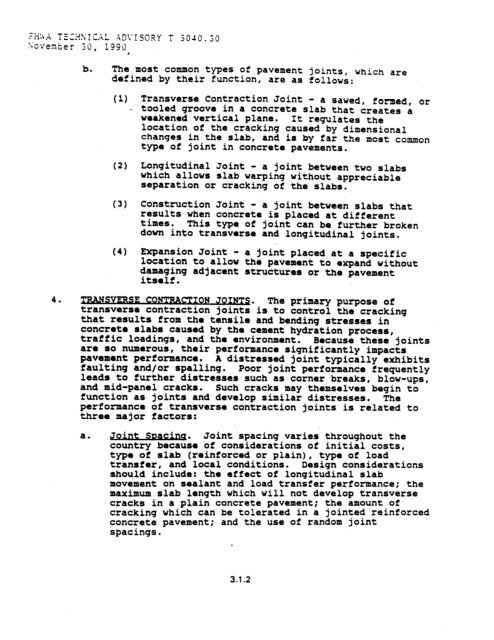chapter 3 rigid pavement - DOT On-Line Publications - Department ...
chapter 3 rigid pavement - DOT On-Line Publications - Department ...
chapter 3 rigid pavement - DOT On-Line Publications - Department ...
Create successful ePaper yourself
Turn your PDF publications into a flip-book with our unique Google optimized e-Paper software.
h. The most common types of <strong>pavement</strong> joints, which are<br />
defined by their function, are as follows:<br />
(1)<br />
(2)<br />
(3)<br />
(4)<br />
. .<br />
Transverse Contraction Joint - a sawed, formed, or<br />
tooled groove in a Concrete slab that creates a<br />
weakened vertical plane. It regulates the<br />
location of the cracking caused by dimensional<br />
changes in the slab, and is by far the most common<br />
type of joint in concrete <strong>pavement</strong>s.<br />
Longitudinal Joint - a joint between two slabs<br />
which allows slab warping without appreciable<br />
separation or cracking of the slabs.<br />
Construction Joint - a joint between slabs that<br />
results when concrete is placed at different<br />
times. This type of joint can be further broken<br />
down into transverse and longitudinal joints.<br />
Expansion Joint - a joint placed at a specific<br />
location to allow the <strong>pavement</strong> to expand without<br />
damaging adjacent structures or the <strong>pavement</strong><br />
itself.<br />
4. W. The primary purpose of<br />
transverse Contraction joints is to control the cracking<br />
that results from the tensile and bending stresses in<br />
concrete slabs caused by the cement hydration process,<br />
traffic loadings, and the environment. Because these joints<br />
are so numerous, their performance significantly impacts<br />
<strong>pavement</strong> performance. A distressed joint typically exhibits<br />
faulting and/or spalling. Poor joint performance frequently<br />
leads to further distresses such as corner breaks, blow-ups,<br />
and mid-panel cracks. Such cracks may themselves begin to<br />
function as joints and develop similar distresses. The<br />
performance of transverse contraction joints is related to<br />
three major factors:<br />
a. Joint S=ciw Joint spacing varies throughout the<br />
country becauie of considerations of initial costs,<br />
type of slab (reinforced or plain), type of load<br />
transfer, and local conditions. Design considerations<br />
should include: the effect of longitudinal slab<br />
movement on sealant and load transfer performance; the<br />
maximum slab length which will not develop transverse<br />
cracks in a plain concrete <strong>pavement</strong>; the amount of.<br />
cracking which can be tolerated in a jointed reinforced<br />
concrete <strong>pavement</strong>; and the use of random joint<br />
spacings.<br />
3.12
















